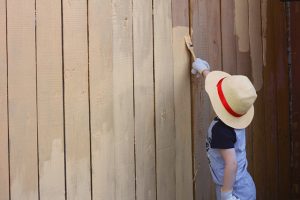Some homeowners like it natural, but there are some cases where paint enhances stylishness and make fences more beautiful. So once your wooden fence is built, you now may want to paint it and here are the things that would be helpful if you intend to undertake this task on your own.
 The main steps you will have to remember are:
The main steps you will have to remember are:
- paint
- sand
- stain
Further than this triptych, here are some helpful tips you need to know:
Every wood is distinctive, and if you are using more than one, they may not absorb the paint similarly.
The task will be easier if you sand the wood entirely so that rough surface becomes smooth and rough spots are evened out. But then avoid sanding it too much as the roughness can also add to the look or design.
Remove all the dust with a damp washcloth after sanding. A wet washcloth is commonly used for this, but you can also make use of TSP. Fully clean the wood to ensure that the paint will stick to the fence. We typically recommend the “chip brush” to paint it; as it’s inexpensive, there are plenty of them, and you can grab one below $1.
Since woods tend to be permeable, this can render your paint job with an irregular texture. It is then recommended to prime your wooden fence before applying the paint. And if you want to go for an aged, rustic appearance, then, you could perhaps skip the primer. Likewise, always begin with the lightest colors if you want to apply few paint colors while utilizing the same brush. However, be mindful that some paint colors don’t blend well. Use a new brush per color, in this case.
How many layers to apply depend on how you want your fence to look. You can do between 1 to 4 coatings. It is highly recommended to let the first coat dry completely before adding another layer. If you want a classic design, you can do only one layer and then sand the wooden fence once more. And if you want a plain appearance then you may apply 4 or more coatings, but sanding, in this case, is not required.
For sanding, we recommend 80-grid sandpaper which is appropriate for all variety of uses. Then stain it or wax it, after painting and sanding, if you want the color to last longer. You can purchase a full set of stain in DIY shops. If you use a chip brush, you can make it last by brush it off on a rag after every usage.
Wood typically takes the stain dark, so it is not recommended to use the Dark Walnut stain, and brighter ones are usually preferred. Remember to stain the entire wooden fence and after applying the stain, wipe it off using a piece of rag or old t-shirt. Then use a layer of bright polish for a glossy finish.